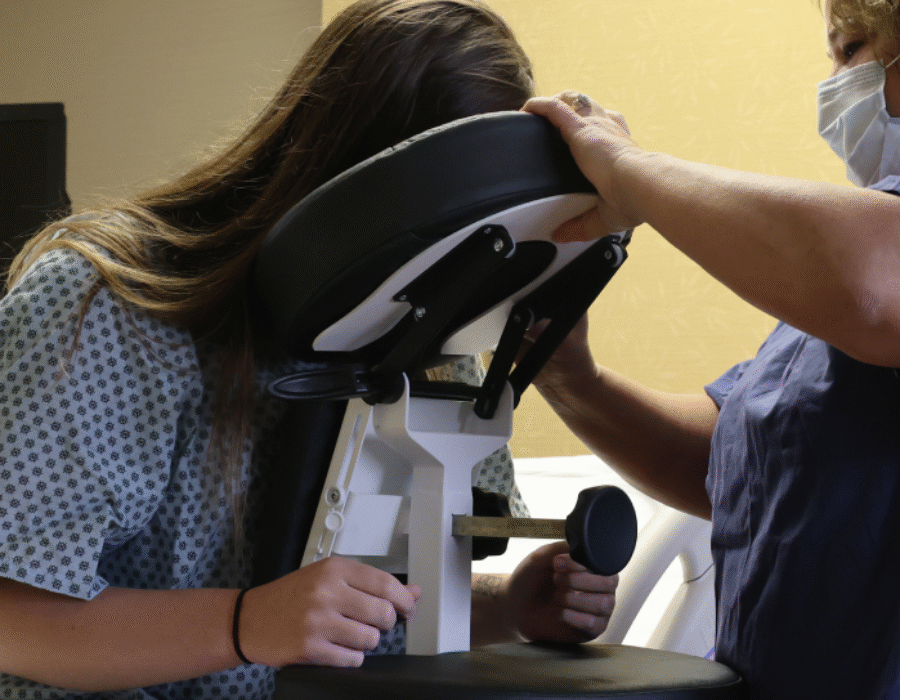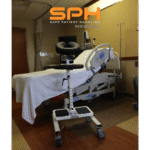The SPH Medical Epidural Positioning Chair is a game changer in terms of improving staff safety and efficiency. In the high-stakes environment of procedural care, nursing staff often find themselves acting as human scaffolding. To ensure the success of critical procedures like epidurals, spinal blocks, and thoracentesis, nurses are frequently required to physically support patients to maintain static, forward-leaning positions. While well-intentioned, this manual holding is a leading cause of preventable musculoskeletal injuries among healthcare staff. It places an unsustainable physical burden on caregivers, diverting their focus from clinical monitoring to physical labor.
The solution lies in replacing manual force with mechanical precision. The Epidural Positioning Device (EPD), also known as the Epidural Positioning Chair, eliminates the physical burden on caregivers. As such, it transforms high-risk manual tasks into safe, controlled processes.
This article will demonstrate how the EPD serves as a critical component of modern Safe Patient Handling (SPH) programs. We will explore how it dramatically reduces workplace injuries, ensures compliance with national safety standards, and optimizes clinical workflow efficiency.
The Hidden Cost of Manual Patient Positioning
For decades, the “tripod” position—where a patient leans forward to open up the vertebral spaces—has been achieved through manual assistance. Nurses and physical therapists often bear the weight of a patient who may be sedated, in pain, or physically unable to support themselves. Using a rickety and unstable bedside table and a stack of pillows to support the patient is also hazardous. Having to catch a falling patient can cause serious injury to the caregiver. These outdated practices carry significant hidden costs for both the individual caregiver and the healthcare facility.
The Biomechanics of Injury
The physical strain placed on a nurse when manually supporting a patient is immense. This task requires the caregiver to maintain a static, often awkward posture while resisting the dynamic weight of the patient. This is known as “static loading,” a mechanism of injury that depletes muscle oxygenation and increases the risk of tissue damage.
Research from the OHSU Biodynamics Laboratory confirms that the forces exerted on the spine during manual handling tasks far exceed safe limits. Even with good body mechanics, the cumulative strain on the lower back and shoulders is dangerous. When you factor in the increasing prevalence of bariatric patients, the risk of sudden, career-altering injury skyrockets. Manual patient positioning is not just physically demanding; biomechanically, it is inherently unsafe.
Epidural Chair Impacts Staff Retention and Operational Costs
The consequences of these injuries extend far beyond physical pain. There is a direct correlation between high rates of musculoskeletal disorders (MSDs) and staff turnover. When experienced nurses are sidelined by injury, facilities face a cascade of operational challenges.
Workers’ compensation claims for patient handling injuries are among the most expensive in the healthcare sector. Beyond the direct financial cost of the claim, facilities must grapple with the indirect costs of lost workdays, the expense of hiring temporary staff, and the loss of institutional knowledge when veteran nurses leave the bedside prematurely. In an era of staffing shortages, protecting the physical well-being of your current workforce is not just a safety goal; it is an operational necessity.
The EPD as a Safe Patient Handling Solution
The most effective way to prevent injury is to eliminate the hazard. The Epidural Positioning Chair is engineered to remove the variable of manual lifting and holding from the procedural equation entirely. It represents a shift from reliance on human effort to reliance on purpose-built technology.
Engineering Safety into the Workflow
The EPD mechanically secures the patient in the correct position, completely removing the need for a nurse to physically hold them. The device features a range of adjustable components—including chest, arm, and head supports—that can be tailored to the specific anthropometrics of each patient.
This mechanical support is particularly critical for the bariatric patient population. The EPD provides a stable, high-weight-capacity platform that supports the patient’s weight safely and securely. By transferring the load to the device, the nurse is protected from the extreme physical exertion required to stabilize a heavy patient manually. The EPD transforms a chaotic, physically demanding struggle into a calm, static event where safety is engineered into the workflow.

Epidural Chair Aligns with National Safety Standards
Adopting the EPD is a decisive step toward compliance with national safety guidelines. Both the American Nurses Association (ANA) and the Association of perioperative Registered Nurses (AORN) have published rigorous Safe Patient Handling and Mobility (SPHM) standards.
Specifically these guidelines explicitly advocate for the use of technology to eliminate high-risk manual tasks.
Modern safety culture demands the “elimination” of risk, not just the management of it. Providing staff with an Epidural Positioning Chair aligns your facility with these best practices. The EPD demonstrates a commitment to a culture of safety where the “zero-lift” philosophy is applied not just to transfers, but to patient positioning as well.
Maximizing Clinical Efficiency and Resource Allocation
Beyond safety, the Epidural Positioning Chair serves as a powerful tool for operational efficiency. In a resource-constrained healthcare environment, the ability to do more with less is invaluable.
Doing More with Less
Traditionally, positioning a patient for an epidural or thoracentesis is a two-person job: one clinician to perform the procedure and one nurse dedicated solely to holding the patient. This manual support consumes a valuable staff resource for the duration of the procedure.
The EPD transforms this dynamic. Once the patient is positioned and secured in the device, the mechanical support takes over. The nurse is no longer required to act as a physical prop. This frees them to focus on their primary clinical responsibilities: monitoring vital signs, charting, managing patient anxiety, and assisting the proceduralist with sterile technique. In many cases, this allows procedures to be managed with fewer staff members, optimizing resource allocation across the unit.
Standardization of Care
Variability is the enemy of efficiency. Manual positioning introduces significant variability; the quality of the patient’s position depends entirely on the physical strength and technique of the nurse holding them. The EPD creates a reproducible, standardized position for every procedure.
This consistency leads to faster procedure times. When a patient is mechanically stabilized in the optimal position, the anesthesiologist can often access the site more quickly and accurately. A correct position means spine correctly flexed and the shoulders relaxed. Reducing the time it takes to “get the patient right” streamlines the entire process, leading to predictable outcomes and a more efficient throughput in procedural areas.
The Epidural Positioning Chair is not merely a convenience; it is a critical piece of safety infrastructure. It protects your most valuable asset—your staff—from debilitating injuries while simultaneously streamlining clinical operations. Accordingly, by eliminating the physical demands of manual holding, facilities can reduce overall costs. This includes workers’ compensation costs, improve staff retention, and ensure compliance with rigorous Safe Patient Handling standards.
Stop relying on manual labor for static positioning. It is time to engineer safety into your procedures. Contact SPH Medical today to integrate the Epidural Positioning Device into your facility and build a safer, more efficient procedural environment for your team.


